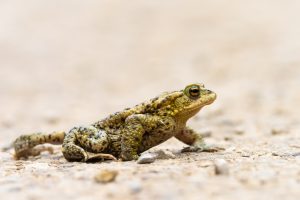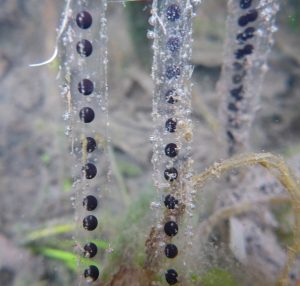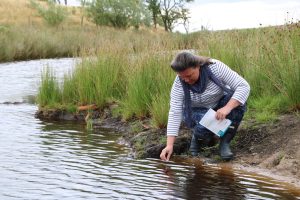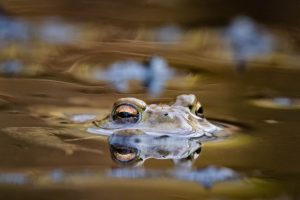Nidderdale volunteers discover record number of sites for Common Toad
6th September 2022
Local volunteers in Nidderdale Area of Outstanding Natural Beauty (AONB) have increased records for ponds known to be colonised by the Common Toad by 30%.
Pond surveys, organised by Freshwater Habitats Trust and Nidderdale AONB and funded by Yorkshire Water, uncovered 17 sites, which were previously not known to be inhabited by the ‘at risk’ amphibian.
The data adds to Freshwater Habitats Trust’s knowledge of freshwater wildlife in Nidderdale AONB. The national conservation charity has recognised the AONB as being part of an Important Freshwater Landscape because of its clean, unpolluted water and high numbers of freshwater species. Situated in the Yorkshire Dales and stretching from the eastern flanks of the Yorkshire Pennines to the high moorland of Great Whernside and the edge of the Vale of York, the 233-square mile AONB provides a diverse mix of habitats for wildlife.

Despite its name, the Common Toad is now classed as an ‘at risk’, Biodiversity Action Plan (BAP) species in England and Wales. Research from the charity Froglife has revealed a 68% decline in Britain’s Common Toad populations in the last 30 years. Like other amphibians, the Common Toad is threatened by habitat loss and water pollution. Large numbers of toads are killed on our roads each year, when they migrate to their ancestral ponds to breed.
Following a volunteer recruitment drive by Freshwater Habitats Trust, more than 60 local people signed up to survey ponds, lakes and reservoirs. They were given training to identify different types of amphibians, carry out water quality testing and submit their data. The volunteers then visited 118 countryside ponds across 58 sites to count toads and toad tadpoles and test water bodies for pollutants.
Volunteers submitted 245 records from sites in Nidderdale AONB to Freshwater Habitats Trust’s national spawn survey, which is an annual monitoring programme of frog and toad spawn.

Kate Wright, Freshwater Habitats Trust and Nidderdale AONB Project Officer for Saving Nidderdale’s Priority Ponds, said: “We are absolutely over the moon to have recruited so many volunteers for our toad survey. We originally set a target to survey 50 ponds. Together, our volunteers smashed that target and surveyed a staggering 118 ponds across 58 different sites, significantly increasing our knowledge of where the Common Toad is living in Nidderdale AONB.
“Nidderdale AONB is a stunning landscape, with many clean water ponds, which are rich in wildlife. These small water bodies are often overlooked but provide important habitats to an incredible range of plant and animal species.
“We know that the Common Toad is rapidly declining and this survey has shown us which sites in Nidderdale AONB we need to focus on to protect this species. This, along with the water quality data collected by volunteers, will help us to ensure Nidderdale AONB remains a special place for freshwater wildlife.”
Nicola Mercer, a health and safety consultant who lives on the outskirts of Fellbeck, volunteered to take part in the toad survey along with her husband Eddie. The couple have developed their garden as a haven for wildlife, including creating new ponds. She said: “We’ve always been interested in wildlife so when we found out about the survey we were very keen to get involved. It was fascinating to find out more about the water quality of our own ponds and learn about the lifecycle of amphibians.

“Volunteering has helped us understand the importance of water quality to wildlife and the impacts of nitrates and phosphates. We were pleased to learn that our ponds have very clean, unpolluted water, but it was quite a different story in some of the other sites.
“To protect wildlife, you need to have as much data as possible so I’m thrilled that we beat our target and found out more about where toads live in Nidderdale AONB. It’s been very rewarding to do something to help local wildlife.”
Freshwater Habitats Trust and Nidderdale AONB staff and volunteers will continue to carry out water testing throughout 2022, aiming to test 250 ponds. This will identify how many of the AONB’s ponds are unpolluted, clean water bodies, which freshwater wildlife needs to survive.
Common Toad facts
- Common Toad can be distinguished from the similar-looking Common Frog by its drier, more warty skin and its striking coppery eye.
- Toads move by walking, rather than hopping.
- The Common Toad’s skin contains powerful toxins to deter predators.
- Toads have a strong migratory instinct and follow the same route back to their ancestral breeding ponds each spring. Sadly, this annual mass migration can result in high numbers of road deaths.
- Breeding toads congregate in early spring, often a couple of weeks after frogs. After breeding, they return to a solitary lifestyle in more terrestrial habitats.
- Toadspawn is laid in characteristic strings, rather than clumps. The eggs hatch after around 12 days, with tadpoles taking around three months to metamorphose into adults.
- Common Toads are most active at night when they hunt for their favourite foods, which include snails, slugs, ants and spiders.
- Toads hibernate over winter and often retreat under log piles, large stones or flower pots.
- Common Toads can live for up to 40 years.

Main image: Iain Mann/Nidderdale AONB
